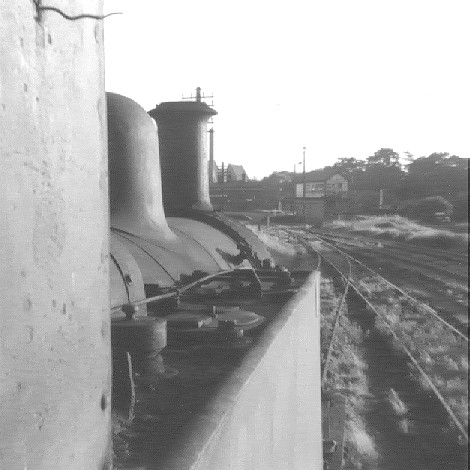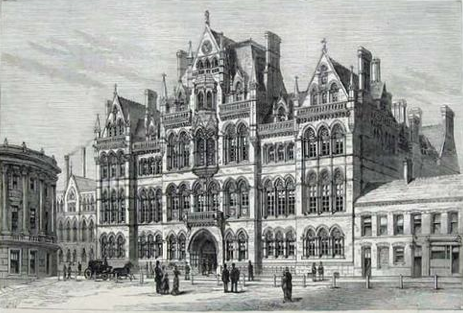|
Midland Railway 2441 Class
The Midland Railway (MR) 2441 Class was a class of steam locomotive. Introduced by Samuel Johnson in 1899, originally with round-topped fireboxes. Henry Fowler later rebuilt them with Belpaire fireboxes. They were given the power classification 3F. The LMS Fowler Class 3F of 1924 was based on this design. Numbering Sixty locomotives were built. Initially numbered 2441–2460, 2741–2780; they were renumbered 1900–1959 in the Midland Railway's 1907 renumbering scheme. All passed to the London, Midland and Scottish Railway, initially retaining their MR numbers, before being renumbered 7200–7259 between 1934 and 1937. All passed into British Railways ownership in 1948 and were numbered 47200–47259. Withdrawal Withdrawals started in 1954, with three locomotives still in service on 1 January 1966. All were scrapped, though several later LMS locomotives have survived. Accidents and incidents *On 12 July 1932, locomotive No. 1909 was hauling a freight train that collided ... [...More Info...] [...Related Items...] OR: [Wikipedia] [Google] [Baidu] |
Coupling Rods
A coupling rod or side rod connects the driving wheels of a locomotive. Steam locomotives in particular usually have them, but some diesel and electric locomotives, especially older ones and shunters, also have them. The coupling rods transfer the power of drive to all wheels. Development Locomotion No. 1 was the first locomotive to employ coupling rods rather than chains. In the 1930s reliable roller bearing coupling rods were developed. Allowance for vertical motion In general, all railroad vehicles have spring suspension; without springs, irregularities in the track could lift wheels off the rail and cause impact damage to both rails and vehicles. Driving wheels are typically mounted so that they have around 1 inch (2.5 cm) of vertical motion. When there are only 2 coupled axles, this range of motion places only slight stress on the crank pins. With more axles, however, provision must be made to allow each axle to move vertically independently of the others without be ... [...More Info...] [...Related Items...] OR: [Wikipedia] [Google] [Baidu] |
Henry Fowler (engineer)
Sir Henry Fowler, (29 July 1870 – 16 October 1938) was an English railway engineer, and was chief mechanical engineer of the Midland Railway and subsequently the London, Midland and Scottish Railway. Biography Fowler was born in Evesham, Worcestershire, on 29 July 1870. His father, also named Henry, was a furniture dealer, and his family were Quakers. He was educated at Prince Henry's Grammar School, Evesham (now Prince Henry's High School, Evesham), and at Mason Science College (which became the University of Birmingham) between 1885 and 1887 where he studied metallurgy. He served an apprenticeship under John Aspinall at the Lancashire and Yorkshire Railway (L&YR)'s Horwich Works from 1887 to 1891. Fowler was a elected as a Whitworth Exhibitioner in 1891. He then spent four years in the Testing Department under George Hughes, whom he succeeded as head of the department. Between 1895 and 1900, he was gas engineer of the L&YR, moving on 18 June 1900 to the Midland Rai ... [...More Info...] [...Related Items...] OR: [Wikipedia] [Google] [Baidu] |
Railway Locomotives Introduced In 1899
Rail transport (also known as train transport) is a means of transport that transfers passengers and goods on wheeled vehicles running on rails, which are incorporated in tracks. In contrast to road transport, where the vehicles run on a prepared flat surface, rail vehicles (rolling stock) are directionally guided by the tracks on which they run. Tracks usually consist of steel rails, installed on sleepers (ties) set in ballast, on which the rolling stock, usually fitted with metal wheels, moves. Other variations are also possible, such as "slab track", in which the rails are fastened to a concrete foundation resting on a prepared subsurface. Rolling stock in a rail transport system generally encounters lower frictional resistance than rubber-tyred road vehicles, so passenger and freight cars (carriages and wagons) can be coupled into longer trains. The operation is carried out by a railway company, providing transport between train stations or freight customer facil ... [...More Info...] [...Related Items...] OR: [Wikipedia] [Google] [Baidu] |
Vulcan Foundry Locomotives
Vulcan may refer to: Mythology * Vulcan (mythology), the god of fire, volcanoes, metalworking, and the forge in Roman mythology Arts, entertainment and media Film and television * Vulcan (''Star Trek''), name of a fictional race and their home planet and language in the ''Star Trek'' franchise * Black Vulcan, a fictional African American superhero on the animated series ''Super Friends'' * Kamen Rider Vulcan, a character in the series ''Kamen Rider Zero-One'' * Vulcan, a fictional planet in the ''Doctor Who'' season ''The Power of the Daleks'' Print * ''Vulcan'' (Fleetway), a 1975–1976 IPC Comic * Vulcan (DC Comics), a fictional character * Vulcan (Marvel Comics), a fictional supervillain * ''Vulcan!'', a 1978 ''Star Trek'' novel by Kathleen Sky * ''The Vulcan'', a magazine from various organizations within the Young Fine Gael * ''Vulcan'', a gay pornography magazine, made famous in a High Court test case by serial killer Dennis Nilsen * Vulcan, a fictional series of artifi ... [...More Info...] [...Related Items...] OR: [Wikipedia] [Google] [Baidu] |
Midland Railway Locomotives
Midland may refer to: Places Australia * Midland, Western Australia Canada * Midland, Albert County, New Brunswick * Midland, Kings County, New Brunswick * Midland, Newfoundland and Labrador * Midland, Ontario India * Midland Ward, Kohima, Nagaland Ireland * Midland Region, Ireland United States * Midland, Arkansas * Midland, California * Midoil, California, formerly Midland * Midland, Georgia * Midland, Indiana * Midland, Kentucky * Midland, Louisiana * Midland, Maryland * Midland, Michigan * Midland, Missouri * Midland, North Carolina * Midlands of South Carolina * Midland, Ohio * Midland, Oregon * Midland, Pennsylvania * Midland, South Dakota * Midland, Tennessee * Midland, Texas * Midland, Virginia * Midland, Washington * Midland City, Alabama Railways * Buenos Aires Midland Railway, a former British-owned railway company in Argentina * Colorado Midland Railway, US * Florida Midland Railroad (other), US * Midland Railroad (Massachusetts), US * Midland Railway, ... [...More Info...] [...Related Items...] OR: [Wikipedia] [Google] [Baidu] |
Catch Point
Catch points and trap points are types of turnout which act as railway safety devices. Both work by guiding railway carriages and trucks from a dangerous route onto a separate, safer track. Catch points are used to derail vehicles which are out of control (known as ''runaways'') on steep slopes. Trap points are used to protect main railway lines from unauthorised vehicles moving onto them from sidings or branch lines. Either of these track arrangements may lead the vehicles into a sand drag or safety siding, track arrangements which are used to safely stop them after they have left the main tracks. A derail is another device used for the same purposes as catch and trap points. Trap points ''Trap points'' are found at the exit from a siding or where a secondary track joins a main line. A facing turnout is used to prevent any unauthorised movement that may otherwise obstruct the main line. The trap points also prevent any damage that may be done by a vehicle passin ... [...More Info...] [...Related Items...] OR: [Wikipedia] [Google] [Baidu] |
Scrap
Scrap consists of Recycling, recyclable materials, usually metals, left over from product manufacturing and consumption, such as parts of vehicles, building supplies, and surplus materials. Unlike waste, scrap Waste valorization, has monetary value, especially recovered metals, and non-metallic materials are also recovered for recycling. Once collected, the materials are sorted into types — typically metal scrap will be crushed, shredded, and sorted using mechanical processes. Scrap recycling is important for creating a more sustainable economy or creating a circular economy, using significantly less energy and having far less environmental impact than producing metal from ore. Metal recycling, especially of structural steel, Ship breaking, ships, used manufactured goods, such as Vehicle recycling, vehicles and white goods, is a major industrial activity with complex networks of wrecking yards, sorting facilities and recycling plants. Processing Scrap metal originates both ... [...More Info...] [...Related Items...] OR: [Wikipedia] [Google] [Baidu] |
LMS Fowler Class 3F
The London Midland and Scottish Railway (LMS) Fowler 3F is a class of steam locomotive, often known as Jinty. They represent the ultimate development of the Midland Railway's six-coupled tank engines. They could reach speeds of up to 60 mph (97 km/h). Introduction Design of this class was based on rebuilds by Henry Fowler of the Midland Railway 2441 Class introduced in 1899 by Samuel Waite Johnson. These rebuilds featured a Belpaire firebox and improved cab. 422 Jinties were built between 1924 and 1931; this class was just one of the Midland designs used on an ongoing basis by the LMS. The locomotives were built by the ex-L&YR Horwich Works and the private firms Bagnall's, Beardmores, Hunslet, North British and the Vulcan Foundry. Details When new, they were numbered 7100–7149, 16400–16764. Numbers 7150–7156 were added when the LMS absorbed the Somerset and Dorset Joint Railway locomotives in 1930. In the 1934 LMS renumbering scheme, the locomotives ... [...More Info...] [...Related Items...] OR: [Wikipedia] [Google] [Baidu] |
Belpaire Firebox
The Belpaire firebox is a type of firebox used on steam locomotives. It was invented by Alfred Belpaire of Belgium in 1864. Today it generally refers to the shape of the outer shell of the firebox which is approximately flat at the top and square in cross-section, indicated by the longitudinal ridges on the top sides. However, it is the similar square cross-section inner firebox which provides the main advantages of this design i.e. it has a greater surface area at the top of the firebox where the heat is greatest, improving heat transfer and steam production, compared with a round-top shape. The flat firebox top would make supporting it against pressure more difficult (e.g. by means of girders, or stays) compared to a round-top. However, the use of a similarly shaped square outer boiler shell allows simpler perpendicular stays to be used between the shells. The Belpaire outer firebox is, nevertheless, more complicated and expensive to manufacture than a round-top version. Due ... [...More Info...] [...Related Items...] OR: [Wikipedia] [Google] [Baidu] |
Samuel Waite Johnson
Samuel Waite Johnson (14 October 1831 – 14 January 1912) was an English railway engineer, and was Chief Mechanical Engineer (CME) of the Midland Railway from 1873 to 1903. He was born in Bramley, Yorkshire and educated at Leeds Grammar School. Career Johnson learned to become an engineer at the locomotive builders E.B.Wilson and Company. In 1859 Johnson became Acting Locomotive Superintendent at the Manchester, Sheffield and Lincolnshire Railway. In 1864 he was appointed Locomotive Superintendent of the Edinburgh and Glasgow Railway. In 1866, after only two years in Scotland he replaced Robert Sinclair of the Great Eastern Railway (GER) at Stratford Works. There he stayed for seven years until moving to the Midland Railway (MR) at Derby, where he stayed until his retirement in 1904. At the time of appointment to the Midland Railway on 1 July 1873, he was paid a salary of £2,000 per year (), rising to £3,500 in 1896 () where it remained until his retirement on 31 ... [...More Info...] [...Related Items...] OR: [Wikipedia] [Google] [Baidu] |





.jpg)
.jpg)